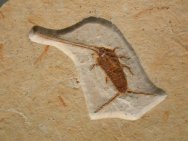 Description:
The Araripe Basin of Brazil is home to a fantastic array of exquisitely-detailed
Early Cretaceous fossils, some of which have been preserved in three
dimensions. While the entire formation has until the last decade
or so been termed the Santana Formation, David Martill has separated
out the slightly older insect-bearing strata as the Nova Olinda
Member of the Crato Formation. Quarrying operations for the purposes
of obtaining paving stones exposes the remarkable insect fauna in
much the same way that quarrying for lithographic limestone in Solnhofen
has afforded a panoply of wonderfully-preserved Jurassic fossils
in Germany. In addition to the many orders of insects, spiders,
scorpions, decapod crustaceans, and many plants have been found.
Interestingly, to date no pterosaurs or terrestrial vertebrates
have been found, in stark contrast to the overlying Santana Formation
deposits. This fine example shows a bristletail. The Bristletails
are members of the Thysanura, a member of the Sub-Class Apterygota,
or wingless insects. They are thought to be the most primitive of
insects, and may never have had wings throughout their evolutionary
history. Interestingly, while they are of primitive design, the
fossils of the Crato Formation are the oldest known examples, rather
than the Devonin, leaving a gap of nearly 280 million years in the
fossil record of the order. Description:
The Araripe Basin of Brazil is home to a fantastic array of exquisitely-detailed
Early Cretaceous fossils, some of which have been preserved in three
dimensions. While the entire formation has until the last decade
or so been termed the Santana Formation, David Martill has separated
out the slightly older insect-bearing strata as the Nova Olinda
Member of the Crato Formation. Quarrying operations for the purposes
of obtaining paving stones exposes the remarkable insect fauna in
much the same way that quarrying for lithographic limestone in Solnhofen
has afforded a panoply of wonderfully-preserved Jurassic fossils
in Germany. In addition to the many orders of insects, spiders,
scorpions, decapod crustaceans, and many plants have been found.
Interestingly, to date no pterosaurs or terrestrial vertebrates
have been found, in stark contrast to the overlying Santana Formation
deposits. This fine example shows a bristletail. The Bristletails
are members of the Thysanura, a member of the Sub-Class Apterygota,
or wingless insects. They are thought to be the most primitive of
insects, and may never have had wings throughout their evolutionary
history. Interestingly, while they are of primitive design, the
fossils of the Crato Formation are the oldest known examples, rather
than the Devonin, leaving a gap of nearly 280 million years in the
fossil record of the order.
|